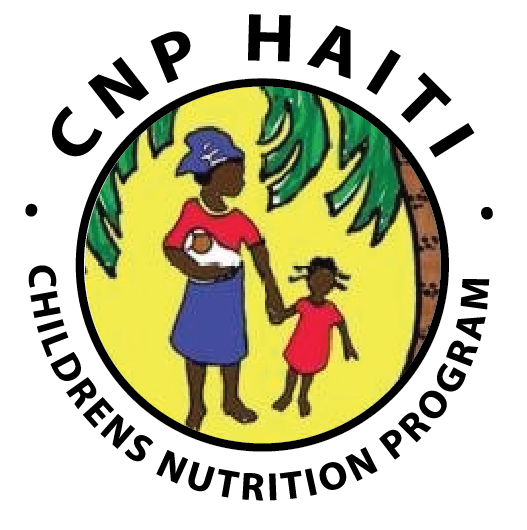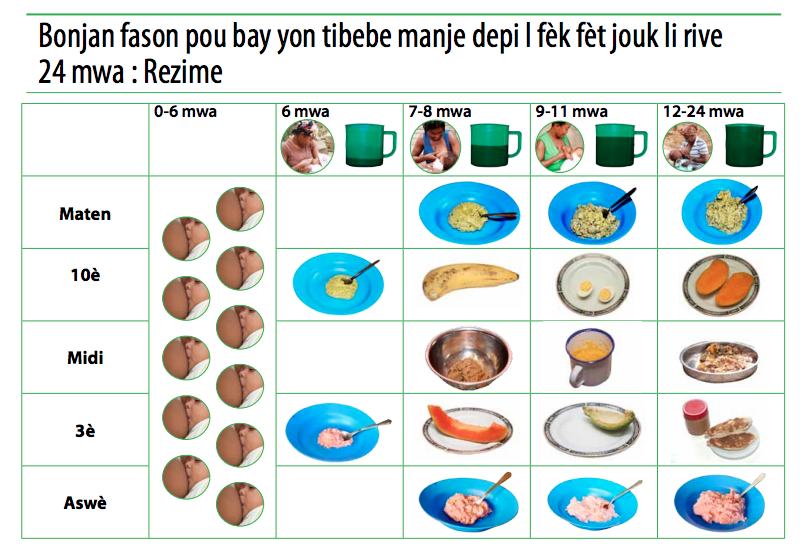Nutrition Recertification Training - Ministry of Health
In the battle against childhood malnutrition in Léogâne, our monitrices are on the front lines. We are constantly looking for ways to improve their knowledge and expand their competencies so they can enter the field each day optimally prepared to handle whatever challenges they may face.
Recently, Haiti’s Ministry of Health sent a delegation of national and regional MOH representatives to put on a special week-long nutrition recertification training for our field workers. As the MOH’s implementing partner in Léogâne, we must ensure that our people in the monitrices know the proper protocols inside and out. Wonder what kind of nutritional knowledge is required before a monitrice hits the field? Below is a (non-exhaustive) review of what was covered.
A group of our monitrices with Rose Elene (third from left) and Nurse Martha and Nurse Guirlene (right) of the MOH
The Food
The week kicked off with a thorough review of the Haitian food pyramid and the three main food groups: (from bottom to top) foods that protect the body, foods that provide energy, and foods that construct the body. The group discussed the different vitamins and minerals essential to healthy development in children and mothers along with their sources and functions.
Meal planning
As our monitrices regularly work with families of little means, they spent ample time imagining balanced meals on an extremely tight budget. The ladies split up into groups to plan a day of inexpensive meals for a family of four. Each group presented and critiqued each other’s plans, rounding out the days and sharing ideas.
Example: a nutritious, balanced day
Breakfast
bread with peanut butter, mango
Lunch
rice with green pigeon beans
smoked herring with tomatoes and onions
grapefruit juice
Dinner
“Labouyi” - boiled cow’s milk with flour and lemongrass
Breastfeeding
Breastfeeding is central to starting children along a healthy path. Our monitrices are well aware, as evidenced by several shirts and hats in the crowd with the words “Ann kore bay tete” (let’s support breastfeeding).
Our monitrices, most of whom are mothers themselves, are familiar with methods of stimulating milk production and encouraging latching in babies. From different positions for different situations to techniques to get the baby to latch on to how to best accommodate twins, our monitrices shared their insights and what they’ve learned in the classroom, at home, and in the field.
In remote areas, the biggest obstacles to successful breastfeeding are often myths and mistaken beliefs. Several monitrices shared concerns they’ve encountered in the field:
“My milk has changed color and consistency; I better not breastfeed in case I’m having a problem that could endanger my baby.”
“I’m not feeling well, I don’t want to pass my illness on to my child.”
“My newborn needs more than just breastmilk to stay strong.”
Rose Elene, our resident lactation consultant, emphasized that once again, it all comes down to education: “If we can educate these mothers and leave them with the knowledge and confidence they need to breastfeed, we won’t see malnutrition in children under six months old.” Rose Elene helped the MOH facilitators educate the monitrices on how to respond to common concerns and how to work with mothers, families, and communities to dispel mistaken beliefs surrounding breastfeeding.
Nutrition: 0 – 24 Months
The ladies once again split up into groups and were tasked with planning meals for the five different age groups under 2 years old, using the MOH’s framework:
Identifying and treating malnutrition
Growth monitoring is the backbone of our outreach in the remote areas of Léogâne, so we reviewed the relationships among age, height, weight, and mid-upper arm circumference. The Ministry of Health has established precise criteria (based on these measurements) for referrals* to one of three treatment programs:
PNS: Nutritional Supplement Program – for moderate acute malnutrition
PTA: Therapeutic Ambulatory Program – for severe acute malnutrition without complications
USN: Nutritional Stabilization Unit – for severe acute malnutrition with decreased appetite and/or medical complications
*We treat PTA and PNS cases in our ambulatory clinics, decentralized outpatient care sites that allow us to reach the maximum number of patients by bringing our services closer to their homes. Our friends at the Ministry of Health expressed interest in replicating our model in other parts of Haiti.
Different types of malnutrition
Marasmas: calorie deficiency
Insufficient energy consumption
Associated with stunting, wasting, increased appetite
Kwashiorkor: protein deficiency
Sufficient calorie intake but insufficient protein consumption
Associated with change in hair pigment, edema*, loss of appetite
*swelling caused by excess fluid in the body’s tissues
Role of the “Ajan Sante” - Community Health Worker
As community nutrition workers, our monitrices are the bridge between the communities they serve and health institutions. The training wrapped up with an overview of the role, importance, and expectations of a community health worker.
Community Mobilization
Community mobilization is the process of engaging communities to identify their needs and priorities and implement solutions. This necessitates an ongoing, continual process, not merely a one-off intervention. A community health worker must collaborate with community leaders to engage the larger community and keep women’s groups and community health committees alive.
To effect significant, sustainable mobilization, one must first understand the challenges communities face and the barriers - cultural, social, and physical - that impede access to healthcare services, especially nutritional interventions:
Limited service hours / distance from services
Lack of confidence in institutions
Lack of knowledge of services offered
Taboos/beliefs about the origins of malnutrition
Stigma/shame
Feeling of guilt (mothers)
Idea that malnutrition is a normal part of life
As an educated member of her community, a monitrice is in a prime position to work with traditional healers and spiritual leaders to change ideas and behaviors surrounding nutrition.
Looking Ahead
Between CNP and the MOH, the training was a great success. Not only did our monitrices reinforce crucial knowledge and competencies and expand their prior knowledge, but they also had opportunities to discuss specific cases and challenges that they have confronted in the field, leading to productive discussions with the experts from the Ministry of Health on how to best follow national protocol in unique situations.
The training allowed the MOH to spend time with all our field staff and gain a better understanding of our work on the ground. Our partnership is essential to our work, and this training has helped to fortify the relationship between CNP and the MOH.
Reminded of the importance and reach of women’s groups and community health committees, the team expressed renewed enthusiasm, and many have taken steps to create, reestablish, or reinvigorate such groups in the communities they serve.
Nadia, for example, immediately began talking to women in the zones she serves to organize women’s groups in her area. Following an initial inquiry process and mobilization efforts, she had fifteen committed members join her for Barye Jedi’s first official meeting in August.
Members of Barye Jedi’s newly established women’s group
A huge "Mèsi” to the Ministry of Health for this training.
Questions? Leave us a comment!





